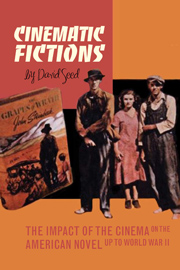Book contents
- Frontmatter
- Contents
- Introduction
- 1 Beginnings
- 2 Modernist Experiments: Gertrude Stein and Others
- 3 H.D. and the Limits of Vision
- 4 Ernest Hemingway: The Observer's Visual Field
- 5 Success and Stardom in F. Scott Fitzgerald
- 6 William Faulkner: Perspective Experiments
- 7 John Dos Passos and the Art of Montage
- 8 Dreiser, Eisenstein and Upton Sinclair
- 9 Documentary of the 1930s
- 10 John Steinbeck: Extensions of Documentary
- 11 Taking Possession of the Images: African American Writers and the Cinema
- 12 Into the Night Life: Henry Miller and Anaïs Nin
- 13 Nathanael West and the Hollywood Novel
- Bibliography
- Index
2 - Modernist Experiments: Gertrude Stein and Others
- Frontmatter
- Contents
- Introduction
- 1 Beginnings
- 2 Modernist Experiments: Gertrude Stein and Others
- 3 H.D. and the Limits of Vision
- 4 Ernest Hemingway: The Observer's Visual Field
- 5 Success and Stardom in F. Scott Fitzgerald
- 6 William Faulkner: Perspective Experiments
- 7 John Dos Passos and the Art of Montage
- 8 Dreiser, Eisenstein and Upton Sinclair
- 9 Documentary of the 1930s
- 10 John Steinbeck: Extensions of Documentary
- 11 Taking Possession of the Images: African American Writers and the Cinema
- 12 Into the Night Life: Henry Miller and Anaïs Nin
- 13 Nathanael West and the Hollywood Novel
- Bibliography
- Index
Summary
Gertrude Stein's Serial Descriptions
The simultaneous emergence of modernism and the cinema helps to explain why writers found in the new medium possibilities of representing and recording experience. In her survey of the impact of the cinema on modernist practice, Laura Marcus has stated that ‘new ways of seeing and animating the object world entered into and shaped literature in the early decades of the [twentieth] century’. Recent studies of modernism have all linked literary experimentation with the new technology of visual representation and David Trotter has argued that the new media promised direct representation of experience while at the same time putting the nature of that existence in doubt. Virtually every writer discussed in this volume was influenced by modernism but the three American writers who will be considered in this chapter – Gertrude Stein, e. e. cummings and William Carlos Williams – all responded directly to the cinema as part of their broader experiments across visual and verbal media. Gertrude Stein's writings can thus be approached as an assault on habits of seeing. In The Geographical History of America (1936) she writes: ‘They used to think that the world was there as we see it but this is not so the world is there as it is human nature is there as it is and the human mind.’ The question of how we see and, even more importantly, how to represent becomes the subject of Stein's experimental prose from an early point in her career.
- Type
- Chapter
- Information
- Cinematic FictionsThe Impact of the Cinema on the American Novel up to World War II, pp. 26 - 48Publisher: Liverpool University PressPrint publication year: 2009



